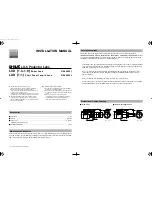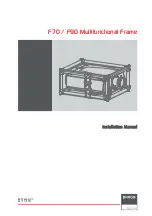
Phadia 100 - User Manual
Reagent and Sample Handling
12-3501-20/12
Page 3.5
3
•
For ImmunoCAP Specific IgA, ImmunoCAP Specific IgG and ImmunoCAP
Specific IgG4 assays: To avoid evaporation and contamination, it is
recommended to recap the QC vials before removing them from the
instrument. This can be done as soon as the pipetting of samples is finished
and the sample incubation is started. For EliA IgA, EliA IgG and EliA IgM
the QC samples are single dose and shall be discarded after the assay.
•
After an assay, unload samples and reagents carefully in the following
order: Stop Solution, Development Solution, Conjugate, QC samples
and finally samples. Calibrators and curve controls are single dose and
shall be discarded after the assay.
•
Perform a Daily Maintenance procedure immediately after each assay.
Points of importance when loading reagents and samples to
an assay run
•
The software will guide you through loading of samples and reagents. Be
sure to load samples and reagents in the correct order and in the correct
place in the Sample Carousel.
•
Avoid handling and mixing samples close to the instrument, reagents and
other components needed for an assay.
•
When mixing samples it is enough to turn the tubes upside down a couple
of times, this also reduces the risk for bubbles in the vials.
•
Do not remove the caps of the sample tubes close to the instrument.
•
If needed, use a disposable pipette tip to pop air bubbles or film on the
surface of samples. Make sure to change tips between each vial. Perform
this step before loading the reagents into the sample carousel.
•
Do not keep the calibrator-, curve control- or conjugate vials open close
to the instrument when loading patient samples.
•
Do not use the same disposable gloves when loading samples and the rest
of the reagents.
•
To reduce the risk for contamination when loading reagents, unscrew
caps on vials and bottles, place vials and bottles into the sample carousel
and finally, remove the caps. If needed, use a disposable pipette tip to pop
air bubbles or film on the surface of the reagents. Make sure to change
tips between each vial. Perform this step before loading the reagents into
the sample carousel.
•
Avoid touching the threads of the caps or vials. Store caps in order to
avoid contamination and mix-ups.
Actions to take when problems occur
•
Do a thorough cleaning of the instrument by performing Monthly
Maintenance, see chapter 11 in Phadia 100 User Manual. When performing
Monthly Maintenance, it is very important to clean the Washing- and
Rinse Solution bottles and the Elution Wells Disc thoroughly to get rid of
all the Maintenance Solution. Please note that Monthly Maintenance is
Summary of Contents for Phadia 100
Page 1: ...Phadia 100 English 12 3501 20 12 User Manual...
Page 81: ...Routine Assay Run Phadia 100 User Manual Page 2 50 12 3501 20 12...
Page 91: ...Reagent and Sample Handling Phadia 100 User Manual Page 3 10 12 3501 20 12...
Page 251: ...Printouts Phadia 100 User Manual Page 10 22 12 3501 20 12...
Page 277: ...Maintenance Phadia 100 User Manual Page 11 26 12 3501 20 12...
Page 341: ...Error Handling Phadia 100 User Manual Page 12 64 12 3501 20 12...
Page 348: ...Phadia 100 User Manual Index 12 3501 20 12 Page 15 1 15 Chapter 15 Index...
















































